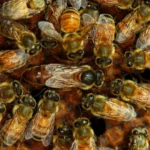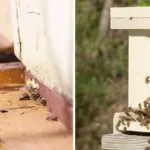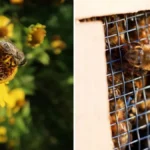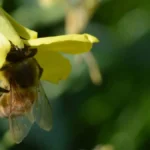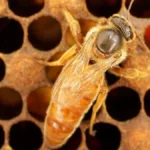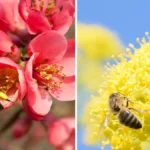Saskatraz bees vs Italian bees? Where do we begin? Saskatraz bees are hybrid bees selected from a wide gene pool for a set of specific traits. Italian bees are a landrace of bees that are maintained and bred according to a set of guidelines. Let’s compare these two types of bees.
Saskatraz Bees Characteristics
Saskatraz bees are a hybrid selected from a range of bees sourced from Saskatchewan. The bees have been selected based on honey production and disease resistance. You can read more about them in this article here on our site.
The important summary is that these bees are sourced and bred in a clever way that keeps genetic diversity, yet selects for diverse genetic traits that make the bees more suited for beekeeping. In this way, they are selected based on disease resistance, and then honey production. The result is a bee that is both disease-resistant and hard working. Saskatraz bees are derived from a diverse stock of managed bees including many different races (eg Italians) and breeds.
Italian Bees Characteristics
Italian bees are somewhere between a breed and a race. They are derived from bees from a region of Italy, and bee breeders breed these bees to have “Italian characteristics”. This is a complex issue as it means that we are enforcing a human eye to the maintenance of a “wild bee” race. In reality, modern Italian bees are not really Italian bees anymore but are more a breed of bees sourced from Italian genetics. They have some characteristics in common with the old Italian landrace of bees.

Learn more about: The Long Horned Bee
Saskatraz Bees vs Italian Bees
Comparing Saskatraz bees vs Italian bees is a bit of a difficult job. This is like asking somebody to compare a screwdriver and a hammer. Both are useful tools – and are designed for different purposes. That is not to say I have not used both a screwdriver and a hammer to open a tin of paint – something neither was designed for. The hammer is designed primarily to cause impact, and the screwdriver primarily to fit in a slot/slots and turn a screw around.
Let us have a look at a few important traits comparing Saskatraz bees vs Italian bees and you can work from there.
Disease Resistance
Saskatraz bees are overall more resistant to disease in general than Italian bees. In this regard, comparing Saskatraz bees vs Italian bees, the Saskatraz bees score way higher. This is an important consideration in a world where disease control is becoming more complex and less effective.
Honey Production
It appears that the selectors for honey production in Saskatraz bees are quite strong and beekeepers do report very good honey yields. There will always be a small trade between honey production and disease resistance. In order to be disease resistant, bees need to invest more energy in fighting disease. This energy would have been honey.
Italian bees are widely regarded as being excellent honey-producing hives. Many of the world’s honey records have been set by these bees. Italian bees are however prone to disease and without careful management and medication/treatment to prevent disease honey production can fail or be very low.
In this regard, on honey production, we are comparing a legacy bee – one for whom there is a lot of literature – with a relatively new hybrid. The Saskatraz bee would be my choice over the Italian bee just because disease resistance is such an important trait. I would much rather run the risk of getting slightly less honey and knowing my bees can fight for themselves than get very good honey yields one year and come back to dead outs the next.
In this regard, comparing Saskatraz bees vs Italian bees I would score the Saskatraz better on long-term stable honey production. I would also score it higher on honey quality – less medication – less contaminated honey.
Overwintering Ability
The Saskatraz bee is selected from genetics that has adapted to Saskatchewan. This is an environment with cold winters. If you look at the graph included there you can see there are only really 5 months of the year when the bees can meaningfully leave the hive. Of these five months, only three will allow enough flight to actually bring in a crop. So these bees are perfect for very cold climates. They are however bred and multiplied in California and do well there too.
If you are in an area that does not have extremely cold winters, then exploring other races of bees is an idea. The fact that warmer climates allow you to inspect your bees and manage the disease more would mean that the benefits of Italian bees can better be unlocked in a warmer climate. Italian bees are definitely not going to overwinter or even survive in the cold climates that Saskatraz bees thrive in.
Comparing the ability of Saskatraz bees vs Italian bees to overwinter in a cold climate, the Saskatraz bees are the clear winners.
An Alternative Between Choosing – Just Mix It Up A Bit!!
This is a personal hobby of mine – genetic diversity. I grew up among scientists and am a scientist with a Ph.D. myself. Since I learned to crawl I heard people talking about genetic diversity and species stability, species loss due to lack of genetic diversity, and so on.
Extinction
In the four and a half decades, I have walked this planet I have seen species vanish. Many of these species have vanished because human interaction killed their genetic diversity, the species became inbred and then just died out.
Genetic Diversity
With honeybees, the only way we will achieve long-term stability in this species is by preserving and enhancing genetic diversity. Bees have very small population numbers. We all look in a box and think “wow lots of bees”. Remember once beehive is the progeny of one bee. If you have 10 hives (queen bees) in your apiary, and those are the only bees around, when the hives requeen, they may inbreed.
Mixed Diverse Bees
If you have an apiary in which you actively encourage diversity, and have a hive that is an Italian hive, next to that you have a Saskatraz and then a Russian, a Carniolan, and then a Buckfast hive. You now have five hives that are genetically relatively unrelated. When they requeen, the offspring will be genetically diverse. If you have a few apiaries set them up on this formula. After a few years start mixing hives from one apiary to another. You will set up a good gene flow system and your bees will get better each year.
I hope that this article has helped you see that there are pros and cons to all “breeds” and “races” of bees. When comparing Saskatraz bees vs Italian bees it helps us see that to survive and thrive we must mix those Pros and Cons and select what we want to see in our bees. You never know – you may start a new breed! If you enjoyed it, please share.
Read more about: Russian Honey Bees vs Italian Bees
Saskatraz vs Italian Honey Bee FAQs
What are the key differences between Saskatraz bees and Italian bees?
Saskatraz bees are a hybrid selected for traits like disease resistance and honey production, while Italian bees are a landrace known for their high honey yields and temperamental nature.
Are Saskatraz bees more resistant to diseases than Italian bees?
Yes, Saskatraz bees are generally more resistant to diseases, making them easier to manage in a beekeeping operation compared to Italian bees.
Which type of bee produces more honey, Saskatraz or Italian bees?
Italian bees are historically known for excellent honey production, but Saskatraz bees are bred to balance disease resistance with strong honey yields, offering stable long-term production.
Can Saskatraz bees survive in colder climates better than Italian bees?
Saskatraz bees are adapted for cold climates like those in Saskatchewan, making them more suitable for overwintering in colder regions than Italian bees.
Do Saskatraz bees or Italian bees require more maintenance?
Italian bees tend to require more maintenance due to their susceptibility to diseases, whereas Saskatraz bees need less intervention because of their robust disease resistance.
How do Saskatraz bees perform in warmer climates?
While bred for cold climates, Saskatraz bees also thrive in warmer areas like California, showing adaptability across different environmental conditions.
Are Saskatraz bees a pure breed like Italian bees?
No, Saskatraz bees are a hybrid developed from a diverse gene pool, whereas Italian bees have a more consistent genetic lineage, though modern Italian bees are now more of a breed than a pure race.
Should I mix Saskatraz and Italian bees in my apiary for genetic diversity?
Yes, mixing different bee types, including Saskatraz and Italian bees, can enhance genetic diversity, improving overall hive health and stability.
Can I use both Saskatraz and Italian bees for honey production?
Yes, both types are productive, but combining their strengths—disease resistance from Saskatraz bees and high honey yields from Italian bees—can benefit your apiary.
Is it better to choose one type of bee, or can I have both Saskatraz and Italian bees?
Having both types in your apiary can create genetic diversity, improving resilience and increasing the chances of better overall bee health.

Dr. Garth A. Cambray is a Canadian/South African entrepreneur and beekeeper with 28 years of experience in apiculture and specializes in adding value to honey. His Ph.D. research developed a new advanced continuous fermentation method for making mead that has resulted in a number of companies globally being able to access markets for mead. His company, Makana Meadery, exports honey mead to the USA where it is available to discerning connoisseurs. He has also developed technologies to commercially manufacture organic honey vinegar in Zambia for export globally. He holds a few patents globally in the ethanol industry and believes in technology and knowledge transfer for human development and environmental sustainability. One of his proudest achievements is the fact that the wind farm he started at one of his old apiary sites has essentially made his hometown carbon neutral.

